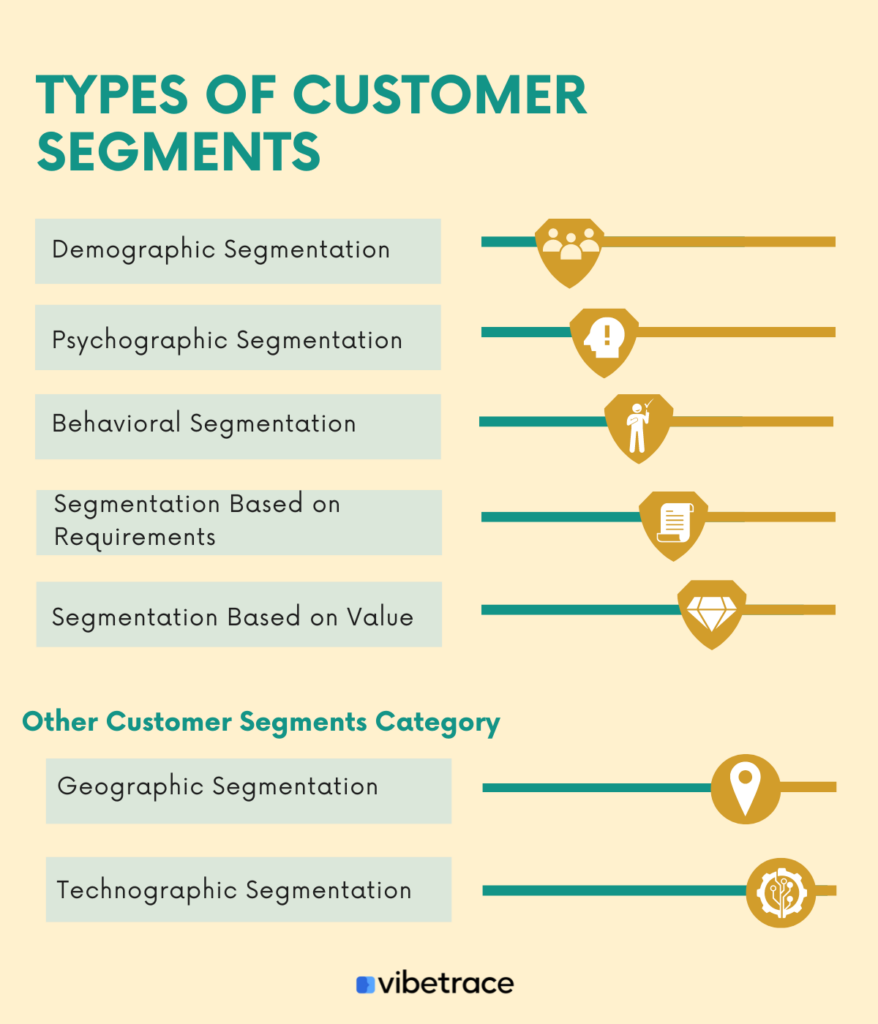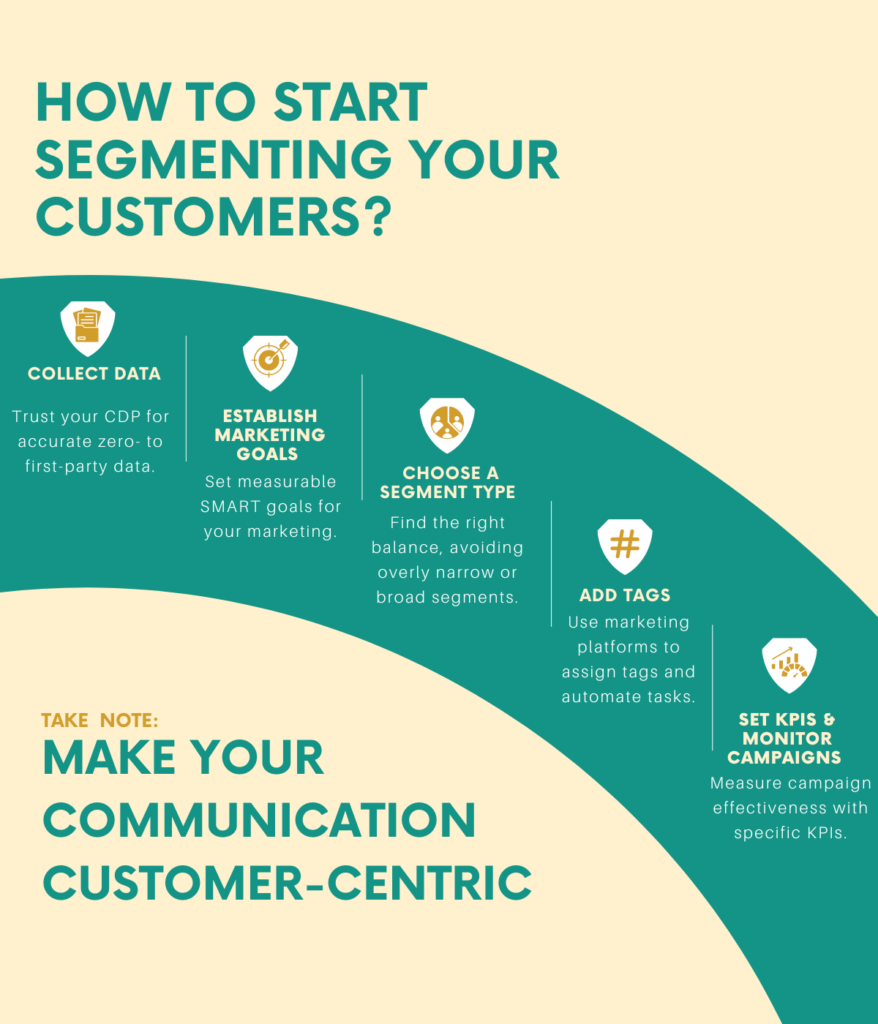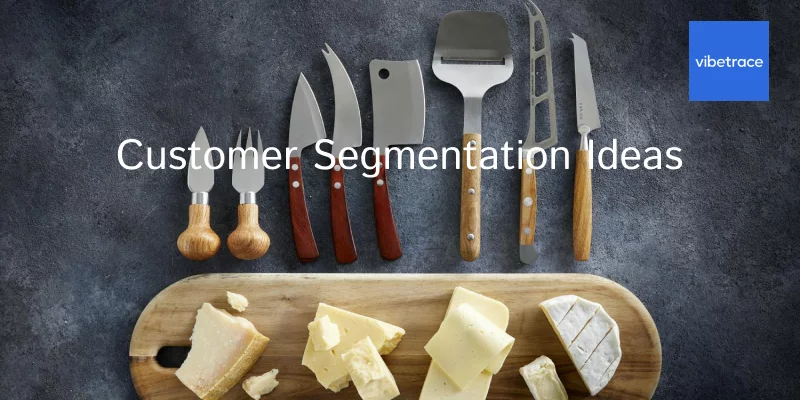How can you reach your ideal customer at the right moment with the best offer possible? There’s only one answer – customer segmentation. The so-called customer data platforms (CDPs) changed how we gather information and target campaigns.
All because CDPs unlocked the doors to detailed customer segmentation.
A customer data platform like the one featured in the all-in-one VibeTrace marketing platform allows you to treat your customers the way they deserve and require of you – as the unique individuals they are.
If you’re after greater engagement and more sales, stick with us to the end. In this post, we’ll discuss, at length, what customer segmentation is and how you can leverage customer segments to achieve higher results. Let’s dive right into it!
What is a Customer Data Platform?
A customer data platform is a software solution that gathers and aggregates data from offline and online channels, creating a centralized data hub. It contains data on your customers and every interaction they have at every touchpoint with your business.
That is an invaluable source of information that you can segment in a practically infinite number of ways to personalize your campaigns. Ultimately, this leads to one thing – boosted engagement and better sales.
According to the latest research by HubSpot, data will play a pivotal role in marketing in 2023 and in the future. It helps:
- 36% of marketers reach their audience more effectively;
- 36% of marketers create highly efficient content;
- 36% of marketers identify the most effective marketing strategies;
- 32% of marketers boost ROI;
- 29% of marketers to improve the experience customers have with brands.
At the same time, 53% of marketers share that their biggest challenge in 2023 will be the lack of quality data. In other words, if you can gather quality data for yourself, you’ll be one step ahead of the competition. And that’s possible with built-in CDPs like the one by VibeTrace.
To achieve the desired results and give your business a massive boost, all you need are the right segments. But what are customer segments in the first place? Let’s see!
What are Customer Segments?
The process of customer segmentation involves separating your customer base into smaller groups united by specific traits, qualities, or buyer behavior. You derive customer segments straight from the data you gather through CDPs.
Since robust customer data platforms aggregate multiple data sources, you can make those segments as detailed or as general as you might want.
Experts Advise: The more detailed you make your segments, the better strategies you can create – go deep when creating customer segments. Still, remember not to make them too narrow!
When you carry out segmentation based on more than just age or location, you can develop tailor-made strategies and targeted campaigns with greater personalization and specific details. And that’s the main reason you need to segment your customers.
That way, you can be present at every touchpoint with the right offer at the right moment and answer customers’ specific needs, requirements, and preferences. In other words – delight them.
That’s the ultimate result of creating customer segments. But what are the overall benefits? We’ll see them in the next section.
Why Segment Customers?
When you adapt your message and approach to customers’ specific desires, you can market to them in a better, more appealing way. Thanks to customer segmentation, you can:
1. Create Enhanced & Personalized Experiences
According to the Adobe Personalization Survey, 89% percent of marketers see a positive effect on ROI when personalizing campaigns. That’s because you speak directly to your customers with the right offers at every stage of their journey.
Remember, every customer is different, and creating custom experiences has a massive impact on results:
- The latest research on personalization suggests that nearly 50% of customers will repeat their purchases if they get a personalized shopping experience. (Twilio)
- 67% of customers require relevant recommendations, and 66% require tailor-made messaging aligned with their needs. (McKinsey)
- 78% of customers are more likely to recommend your brand to friends and family if you offer a personalized experience. (McKinsey)
That goes to show that personalization is a crucial ingredient for success. But to successfully create personalized messages and leverage a product recommendations engine, you need the data and the customer segments you can derive from it.
2. Optimize Targeted Campaigns
Every business dreams of having a vast customer base. What matters most is not the size but how much those customers pay. Are they repeat buyers? Because if not, you’re just missing out on profits.
Customer segmentation helps you better understand how people interact with your business and campaigns. That way, you can optimize your campaigns and subtly nudge customers to the next step in the funnel.
If you treat every customer the same way and target them all with the same message over and over again, results won’t improve. You will most likely fail to drive them to the next stage of the customer lifecycle.
Through customer segmentation, you can create and execute enhanced campaigns, nurture relationships, and show customers you care about them specifically. And that leads to a logical outcome.
3. Boost Sales & Revenue
Data is explicit on this one – campaigns created around customer segmentation can boost revenues by 760%. (Campaign Monitor)
That’s a direct result of increased open rates and CTR and decreased unsubscriptions. Through customer data platforms and customer segments, you can produce relevant content and campaigns. And when that happens, customers start to care.
All because you first showed them you care about their desires and interests.
If you’re still unsure how to segment customers in a meaningful way, below we’ve gathered some of the most popular traits and characteristics. You’ll also discover key customer segment ideas you can extract from your CDP, so keep reading to start improving your marketing campaigns today!
Want to be up to date with Marketing?
Subscribe to our Retail CX newsletter!

Stay connected with what’s really important to optimize your digital revenues.
By clicking the button, you accept our Terms & Conditions. Also you will need to confirm your email address.
Popular Traits Used in Customer Segmentation
First, let me point out that the data your CDP gathers has different sources and thus comes in different types. And by that, I mean the way and the channel used to acquire it. As a result, you’ll have at your disposal four main data types:
- Zero-party data
- First-party data
- Second-party data
- Third-party data
Read more about zero and first party data.
They have their specifics, and we’ve discussed them at length right here. Remember that zero-party data is the most reliable but with the smallest scope, whereas third-party data has greater reach but is the least reliable.
Combining these data types will help you mix and match specific traits, behaviors, and interests to craft efficient messages and reach your ideal customers through meaningful segmentation.
Let’s see some popular examples of traits coming from different data types.
Examples of Popular Traits to Use for Segmentation
The starting point for many businesses is gender and age. Of course, if a company operates locally, location comes close second. To add depth, include the customer journey stage and specific website activity.
For that added touch of personalization, you can assign values and personality traits to your customers. In other words, gathering data and segmenting it relates to the ideal buyer persona (or personas, if there are multiple ones) you’ve fleshed out when you first started your business.
Depending on the predominant characteristics you choose for your customer segments, you can develop several valuable models. Below, we’ll cover in short some of the most popular ones.
Types of Customer Segments
Now that you know what traits are and what data types you can aggregate in a CDP, let’s look at the most common customer segments. They are time-tested models that offer a great starting point when you begin crafting your own customer segments.

1. Demographic Segments
Demographic characteristics are general characteristics shared by social groups. You can use these general characteristics to segment your customers according to their age, marital status, gender, and occupation.
These reveal lots of actionable insights about your target audience – how well-off they are, what they might be interested in, and identify their needs, depending on these characteristics. Consider a 44-year-old customer with a high-paying job – their needs will notably differ from those of a university student.
2. Psychographic Segments
Psychographic characteristics introduce more detail. They usually encompass personality traits that can tell you about your customers’ values and desires.
Depending on their personality, you can adapt your messages and even your tone of voice when communicating with people from different segments. Psychographic characteristics are harder to determine than demographics, but they offer valuable insights that can help you align your offers with your customers’ interests.
3. Behavioral Segmentation
When you consider customer behavior, you can segment your base according to how people interact with your brand. Have they browsed multiple categories without purchasing? Have they added products to their cart and then abandoned them?
Customer behavior on your store and their interactions with campaigns can show you what people care about. These characteristics can even help you tell how close customers are to converting and what actions you can take to move them forward on their journey.
Aspects like activity, engagement, and the stage of their customer journey are all used to create a behavioral segment.
4. Segmentation Based on Requirements
To create such segments, you need to answer why a customer would be interested in your products. What benefits do you offer them if they shop from you?
Every business has a unique selling point and value proposition. When you flesh out your ideal customer and identify their pain points, you can present people in requirement-based segments with relevant offers that target the exact pain points.
Quizzes and surveys are a great way to identify pain points and understand your customers’ requirements.
5. Segmentation Based on Value
Can you tell how valuable each customer is? If you segment your base according to how much they spend on your offers, you can improve your sales strategies.
For example, if you have regular visitors with very few purchases, you can target them with cross-selling offers to increase their value. At the same time, you can reward high-value customers with various bonuses, discounts, loyalty points, and so on to encourage them to continue being at least as valuable.
To segment customers according to their value, you need to monitor their purchasing habits – how often, how much, and what’s the average value of the purchases they make. Additionally, you can target highly satisfied customers specifically. The happier they are, the more loyal they become and the higher their value.
6. Other Customer Segments Ideas
In addition to these segments, it’s worth mentioning two more ideas:
- Geographic Segmentation – when you segment people according to their specific location, it’s easier to keep your offers relevant. People in Alaska don’t usually need discount codes for crop tops.
- Technographic Segmentation – this is a very interesting segment. You can optimize conversion journeys and touchpoint interactions when you know how your customers find you and what devices they prefer. Imagine 80% of your traffic coming from mobile devices and not having at least a responsive site.
Segmentation can be a breeze if you have a robust customer data platform. But your segmentation strategy can’t rely solely on it. In the next section, we’ll discuss how to start and organize the customer segmentation process for a maximum positive impact.
How to Start Segmenting Your Customers?
Business goals are at the forefront of developing a customer segmentation strategy. Whether it’s growth, awareness, boosted customer engagement, enhanced and personalized customer journey and experience, you need to be clear on your goals to develop relevant segments.

The rest includes:
- Collect Data – trust your CDP. It will help you gather and organize data from multiple sources – from zero- to third-party data. Soon enough, acquiring third-party data will be virtually impossible. Use this opportunity to focus on zero- and first-party data. Limited in reach but highly accurate.
- Establish Marketing Goals – when it comes to marketing, what you want to achieve needs to be measurable. The best approach is to set the so-called SMART goals – specific, measurable, attainable, relevant, and time-bound. They will inform the way you segment your customers. That is the next step in the strategy.
- Choose a Segment Type – every idea for customer segments has its advantages and drawbacks. Consider what aligns best with your goals, mix and match traits, and make sure you don’t go too narrow or too broad. If you make segments that are too specific, your efforts might have a direct effect on the results from those specific customers, but they’d be so negligibly few, it won’t affect your overall performance.
- Add Tags – when you use all-in-one marketing platforms like VibeTrace, you can easily assign tags, attributes, and specific events to your customers to group them into specific segments. In turn, those will trigger specific events from your workflows, helping you automate your tasks.
- Set KPIs & Monitor Campaigns – ultimately, the customer segmentation goal is to boost results from marketing campaigns. You know your OKRs and why you’ll use customer segments to achieve them. Now’s the time to settle on specific KPIs to measure the efficiency of your efforts. Depending on your various campaigns (for awareness, engagement, conversions, etc.), set at least one KPI to monitor – CTRs might be appropriate in conversion campaigns, a drop in unsubscribe rates can help you see if your engagement campaign is a success, and so on.
Most importantly, don’t forget to make your communication customer-centric. That’s the whole point of segmentation. And last but not least, treat your segments differently.
Remember – personalizing campaigns and staying relevant are the way to accelerate growth and boost results. Are you ready to begin?
To Recap
Contemporary customers don’t care about promises or features. They care about benefits and brands that care in return.
Through customer segments, you can personalize your campaigns at scale and answer people’s needs and desires with relevant offers.
You can enhance and improve their customer journey and optimize for every possible touchpoint down the conversion path.
To segment efficiently is to know what you want to achieve AND to know your customers. To do that, you must break down data silos and leverage the power of customer data platforms. See the VibeTrace CDP in action – book your demo today!

